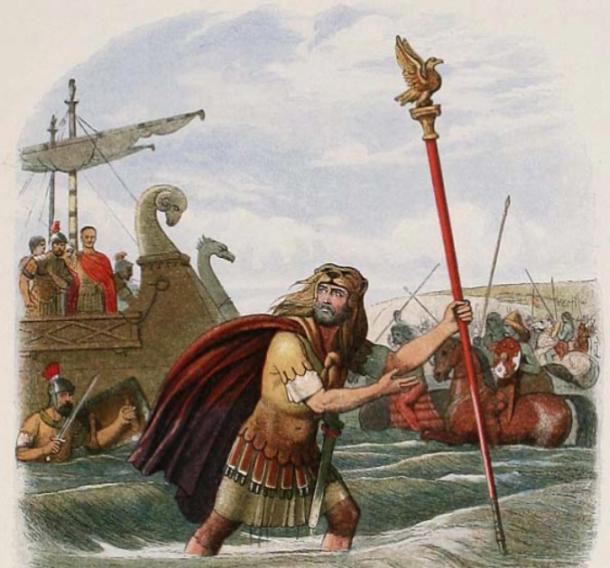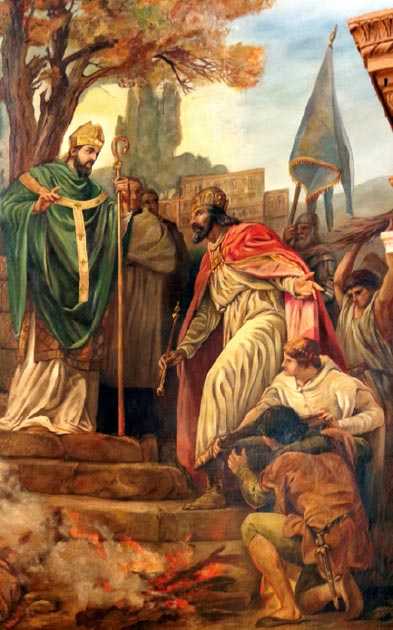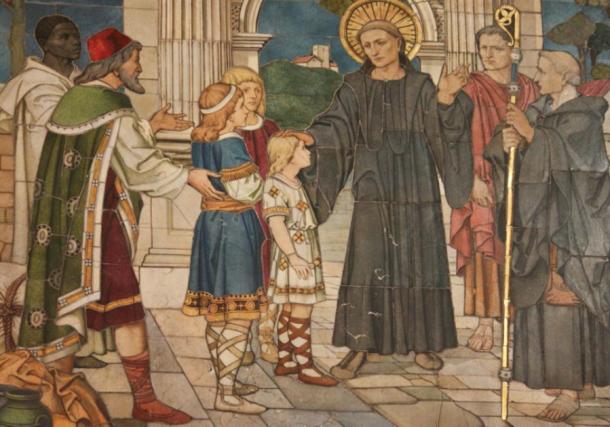
How Anglo-Saxon England Made the Radical Change to Christianity
The Christianization of Anglo-Saxon England began towards the end of the 6 th century AD, and by the end of the succeeding century, all the kings of Anglo-Saxon England were Christian, at least nominally. Thus, the Christianization of Anglo-Saxon England may be said to have been a relatively rapid process. For the Anglo-Saxon rulers, the benefits of Christianity were not restricted to the hereafter, but may have also been reaped during their lives on earth. Indeed, the conversion to Christianity had a huge impact on Anglo-Saxon society and culture.
Arguably the most important source of information for the story of Anglo-Saxon England’s conversion to Christianity (an example of the impact Christianity had on Anglo-Saxon England) is the Ecclesiastical History of the English People, which was completed by the Venerable Bede during the first half of the 8 th century AD.
Romans in Britain: Early Christianity
Although the Christianization of Anglo-Saxon England only began at the end of the 6 th century AD, this does not mean that Christianity had not set foot on the island prior to this time. In 55 BC, Julius Caesar launched the first Roman invasion of Britain. Caesar, however, failed to conquer the island, and it was only in 43 AD, during the reign of Claudius, that the Romans successfully invaded Britain.
The Roman conquest of Britain was a gradual process and was only completed several decades after the initial Claudian invasion. Thus, by the end of the 1 st century AD, Britain was a Roman province, and remained so until the early 5 th century AD.

A portrayal of the Roman Tenth Legion's landing at England in 55 BC—the standard-bearer leaped ashore, inspiring the rest to follow – (James William Edmund Doyle / Public domain)
It was during this period that Christianity first arrived on the shores of Britain. The first Briton to be considered a saint is St Alban, a Roman soldier who was martyred around 303 AD, during the reign of Diocletian. In addition, the 5 th century AD saw the rise of Pelagianism (known also as the Pelagian heresy) in Britain. Pelagius (who was a monk from Britain) and his followers believed in the essential goodness of human nature, and the freedom of human will to choose between good and evil. These views rejected the Church’s teachings on original sin, and the need to rely on God’s grace for the attainment of righteousness.
During the 5 th century AD, the Western Roman Empire collapsed, and the Roman legions withdrew from Britain. As a consequence, Britain was left in a vulnerable position, and fell to the barbarian tribes that crossed the sea from mainland Europe.
Barbaric Germanic Tribes Conquer England
According to Gildas, a 6 th century AD British monk, the defeat of the Britons by the Germanic tribes was brought about by the lack of piety in the leaders of the former. According to Bede, the three Germanic tribes that settled in England were the Angles, the Saxons and the Jutes. Bede also mentions that these tribes came from northern Germany, and that they were invited by Voltigern, a ruler of the Britons, to defend his kingdom against the Picts and Scotti, who occupied the area. Interestingly, the archaeological evidence suggests that the first Germanic migrants arrived in Britain before the withdrawal of the Romans from Britain.
In any case, the power vacuum left behind by the Romans in Britain was filled by the Germanic tribes. The Angles established the kingdoms of East Anglia, Northumbria and Mercia, the Saxons the kingdoms of Wessex, Essex and Sussex, and the Jutes the kingdom of Kent. Unlike the local Britons, the Anglo-Saxons were not Christians, they were pagans. It seems that Christianity was almost wiped out in Britain as a result of this political change.
Unfortunately, we do not have much information about the pagan religious practices of the Anglo-Saxons. Bede, for instance, wrote about this subject, though it is quite unlikely that he witnessed these practices for himself. Bede provides a description of the temples, priests and various gods that the Anglo-Saxons worshipped. This has been pointed out to seem to be based on Greek and Roman mythology.
The Anglo-Saxons themselves are not known to have kept written records. Therefore, it is only through place-names and the archaeological evidence that we are able to gain some insight into Anglo-Saxon paganism. We know, for instance, that the Anglo-Saxon pagans believed that their rulers were the descendants of Woden, the Germanic equivalent of the Norse Odin.
At the time when England was under the rule of pagan Anglo-Saxon kings, the neighboring island of Ireland was being converted to Christianity. According to tradition, it was St Patrick who brought Christianity to the Irish. Although the dates of St Patrick’s life are uncertain, it is generally agreed that he was carrying out his missionary work in Ireland during the 5 th century AD.
St Patrick was born in Britain, and belonged to a Romanized family. At the age of 16, he was captured by Irish raiders, and sold into slavery in Ireland. He spent the next six years of his life as a herdsman. Eventually, St Patrick succeeded in escaping, and returned to his family in Britain.
After he returned home, the saint had a dream, in which he was given a letter entitled ‘The Voice of the Irish’ by one Victoricus. As St Patrick read the letter, he heard the Irish imploring him to walk once more amongst them, which he took as a sign that God wanted him to preach to the Irish.
Thus, St Patrick responded to this call, though only after a long time, since the shortcomings of his education made him hesitant about it. He returned to Ireland, and converted the population to Christianity. As will be seen later on, the Christianization of Ireland would play a role in the conversion of Anglo-Saxon England.
- The Anglo-Saxon Conquerors: Creators of Medieval England
- More Than 80 Exceptionally Rare Anglo-Saxon Coffins Found in Previously Unknown Cemetery
- Glastonbury: Archaeology is Revealing New Truths About the Origins of British Christianity

St Patrick preaching to the king of Ireland on his return (Lawrence OP / CC BY-NC-ND 2.0)
The Pope’s Plan for England
During the 590s AD, the pope, St Gregory I, made plans to convert the Anglo-Saxons to Christianity. Bede provides a colorful tale regarding the pope’s decision to send missionaries to England.
According to this story, St Gregory (prior to becoming pope) was once in the marketplace of Rome looking at the goods that were on sale. He saw some boys with fair complexions and handsome faces being put up for sale, and asked where they were from. The merchant answered that they were from Britain, whose inhabitants all had that pleasant appearance. The future pope then enquired whether the people of Britain were Christians, or if they were still heathens. Upon hearing that they were not Christians, St Gregory sighed deeply, and said “alas that the author of darkness should have men so bright of face in his grip, and that minds devoid of inward grace should bear so graceful an outward form.” St Gregory then asked about the name of the race, the kingdom, and its king, and received “Angli”, “Deiri” and “Aelle” in reply.
For the first answer, St Gregory remarked “they have the faces of angels, and such men should be the fellow-heirs of the angels in heaven.” For the second, “De ira! (Latin for ‘from the anger’) Good! Snatched from the wrath of Christ and called to his mercy.” For the third, “Alleluia! The praise of God the Creator must be sung in those parts.” After this incident, St Gregory went to the pope, and requested that missionaries be sent to convert the Anglo-Saxons to Christianity.

St Gregory encountering some Anglo-Saxon slaves in the Roman market (Lawrence OP / CC BY-NC-ND 2.0)
Regardless of the veracity of Bede’s story, a mission was sent to convert the Anglo-Saxons in 596 AD. By that time, incidentally, St Gregory had become pope. The mission was led by St Augustine (of Canterbury), the prior of the Benedictine monastery in Rome, who was accompanied by 40 of his fellow monks. As the mission arrived in southern Gaul (present-day southern France), they were warned of the ferocity of the Anglo-Saxons, and of the perils that awaited them in England. Therefore, the monks sent St Augustine back to Rome to urge the pope to cancel the mission.
St Gregory, however, was adamant that the mission and in particular, the Christianization of Anglo-Saxon England should continue. He sent St Augustine back with letters of commendation to encourage the other monks. Eventually, in 597 AD, the missionaries landed on the Isle of Thanet, which was under the control of the Kingdom of Kent, and was well-received by its ruler, King Aethelberht I. According to Bede, the king and his entourage met the missionaries outdoors, as Aethelberht was supposedly afraid that the monks would practice sorcery. Local legend states that the meeting occurred under an oak near Ramsgate. During the 19 th century, a stone cross was erected on the site where the meeting was supposed to have taken place, as a commemoration of the event.
St Augustine’s decision to approach the Kingdom of Kent first was probably a calculated one. It was one of the most powerful Anglo-Saxon kingdoms at that time, and its conversion would certainly aid the missionaries’ efforts later on. More important perhaps, is the fact that the king was married to a Christian.
Aethelberht’s wife was Bertha, a Frankish princess of the Merovingian dynasty. Since the pagan king allowed his Christian queen to practice her faith, the missionaries could reasonably expect the king to be sympathetic towards their cause. Although Aethelberht did not convert immediately to Christianity, he treated the monks well. The king allowed the monks to preach freely in his kingdom, and gave them a place to stay in Canterbury, the kingdom’s capital, and the ancient church of St Martin.

St Augustine preaching during Christianization of Anglo-Saxon England (Joseph Martin Kronheim / Public domain)
The Christianization of Anglo-Saxon England and in particular, the efforts of the missionaries soon bore fruit and many people (reportedly in the thousands) converted to Christianity. Eventually, Aethelberht himself became a Christian.
In 598 AD, St Augustine was consecrated as bishop of the English by St Vergilius of Arles. In 601 AD, he was formally given jurisdiction over Britain by the pope, and became the first Archbishop of Canterbury, which is today still the most senior cleric in the Church of England. Incidentally, St Augustine would be more appropriately referred to as the Bishop of Canterbury, since the title ‘archbishop’ was not used until at least 668 AD.
The missionaries achieved success in the kingdoms of Essex and Northumbria as well. In 601 AD, in addition to formally giving St Augustine jurisdiction over Britain, the pope also sent another group of missionaries, amongst who were Mellitus and Paulinus. Mellitus was able to preach the Gospel in Essex, after its king, Saeberht, converted to Christianity at the insistence of Aethelberht (his uncle).
On the other hand, Paulinus accompanied Aethelburh, the daughter of Aethelberht, to Northumbria. She married the Northumbrian king, Edwin, in 625 AD. Eventually, Edwin was converted by Paulinus, and Christianity began to spread in the kingdom soon after.
Setbacks and Resolutions
After these initial successes, however, the missionaries faced a series of setbacks. In 616 AD, Aethelberht died, and was succeeded by his son, Eadbald. In the same year, Saeberht also died. Furthermore, Edwin was slain in battle in 633 AD. This did not bode well for the missionaries, as Eadbald was initially hostile towards Christianity, whilst the sons of Saeberht drove Mellitus out of the kingdom. In addition, as a result of Edwin’s death, Northumbria was plunged into chaos. The death of these three kings also meant that the Christians lost important secular support, and as a consequence, their numbers in the three kingdoms began to dwindle.
Nevertheless, Christianity survived, and overcame these problems. In the case of Eadbald, for instance, the king was eventually converted, whilst Christianity returned to Essex after a few decades. In Northumbria, order was restored in the kingdom following the ascension of Oswald in 634 AD. The king was already Christian, and requested missionaries from Ireland (where he had been exiled) to convert his countrymen to Christianity. St Aidan, who was sent on this mission, had much more success than Paulinus.

Christian saints and missionaries in Anglo-Saxon England (D Adams/ Internet Archive Book Images)
In the decades that followed, Christianity continued its spread in England. Nevertheless, paganism still had one very powerful supporter, King Penda of Mercia. This was the king who defeated and slew both Edwin (in 633 AD) and Oswald (in 642 AD) in battle. Penda himself was defeated and killed by Oswiu (Oswald’s brother and successor) at the Battle of Winwaed in 655 AD, and this marked the end of paganism in Mercia. Within the next 50 years, the kingdoms of Wessex and Sussex were also converted to Christianity.
Finally, it may be said that the Christianization of Anglo-Saxon England had a huge impact on the country. Not only in the religious beliefs of its people, but also in the areas of politics, culture, and society. As an example, Christianity brought with it a writing system, i.e. Latin alphabet that we still use today, and the Latin language. This technology was used by the Anglo-Saxon rulers to create law codes and charters. Additionally, Christian monasteries became the centers of learning, and the ones at Canterbury and Wearmouth-Jarrow (in Northumbria) became renowned throughout Christendom. Apart from that, many beautiful manuscripts were created in these monasteries, and kept in their libraries.
Top image: St Augustine of Canterbury preaches to Aethelberht of Kent during Christianization of Anglo-Saxon England Photo source: James William Edmund Doyle / Public domain
By Wu Mingren
References
Cavendish, R., 2005. Julius Caesar’s First Landing in Britain. [Online]
Available at: https://www.historytoday.com/archive/julius-caesar%E2%80%99s-first-landi...
Dickinson College Commentaries, 2019. Christianity in Anglo-Saxon England. [Online]
Available at: http://dcc.dickinson.edu/bede-historia-ecclesiastica/intro/christianity-...
English Heritage, 2019. Who Was St Augustine?. [Online]
Available at: https://www.english-heritage.org.uk/visit/places/st-augustines-abbey/his...
Faulkner, N., 2011. Overview: Roman Britain, 43 - 410 AD. [Online]
Available at: http://www.bbc.co.uk/history/ancient/romans/overview_roman_01.shtml
Harrison, J., 2019. Who were the Anglo-Saxons?. [Online]
Available at: https://www.bl.uk/anglo-saxons/articles/who-were-the-anglo-saxons
History Extra, 2012. The jokes that Christianised the Anglo-Saxons. [Online]
Available at: https://www.historyextra.com/period/the-jokes-that-christianised-the-ang...
Hudson, A., 2019. Religion in the Anglo-Saxon Kingdoms. [Online]
Available at: https://www.bl.uk/anglo-saxons/articles/religion-in-anglo-saxon-kingdoms
New World Encyclopedia, 2019. Saint Augustine of Canterbury. [Online]
Available at: https://www.newworldencyclopedia.org/entry/Saint_Augustine_of_Canterbury
O'Raifeartaigh, T., 2019. St. Patrick. [Online]
Available at: https://www.britannica.com/biography/Saint-Patrick
The BBC, 2014. The Anglo-Saxons. [Online]
Available at: http://www.bbc.co.uk/history/ancient/anglo_saxons/saxons.shtml
The Editors of Encyclopaedia Britannica, 2019. Anglo-Saxon. [Online]
Available at: https://www.britannica.com/topic/Anglo-Saxon
The Editors of Encyclopaedia Britannica, 2019. Pelagianism. [Online]
Available at: https://www.britannica.com/topic/Pelagianism
The Editors of Encyclopaedia Britannica, 2019. Saint Augustine of Canterbury. [Online]
Available at: https://www.britannica.com/biography/Saint-Augustine-of-Canterbury
Vosper, E., 2019. Migration and conversion: The Christianisation of Britain. [Online]
Available at: https://www.ourmigrationstory.org.uk/oms/migrating-religions-the-christi...
















Comments
Completely ignores the actual history from the Tysilio Chronicle in the Bodleian Library, which Flinders Petrie identified as one of the sources for Geoffrey of Monouth’s incorrectly-maligned Histories… The Catholics (Augustine of England – NOT St Augustine of Hippo) paid/influenced 3 Saxon chieftans who had converted to massacre over 1000 Celtic Christian monks at Bangor-is-y-coed, because they would not accept the (self-proclaimed) authority of the Pope as the leader of Christendom. This effectively gave control to Catholicism.
The Saxons gained control shortly afterwards when a plague broke out amongst the Britons. They didn’t associate with the Saxons, who weretherefore spared, and over 90% of the Britons died. Letters were sent back to Saxony for reinforcements and the Britons were pushed back into Wales.
Yea, in some parts. Also the fact that if the king was Christian, you were too. I'm also sure many of them just instinctively realized it was true.
The rapid conversion to Christianity was due to the tip of a very sharp sword.
Joseph’s actual account has been kept by his descendents through the years and has recently surfaced in New Zealand. It is being translated at the moment. Basically he was set adrift with Mary Magdalene and some other prominent Christians by Saul of Tarsus. God brough them to shore and they made their way to Glastonbury and established the first Christian community outside the Mediterranean. They were not Gnostics.
Joseph’s actual account has been kept by his descendents through the years and has recently surfaced in New Zealand. It is being translated at the moment. Basically he was set adrift with Mary Magdalene and some other prominent Christians by Saul of Tarsus. God brough them to shore and they made their way to Glastonbury and established the first Christian community outside the Mediterranean. They were not Gnostics.
Pages